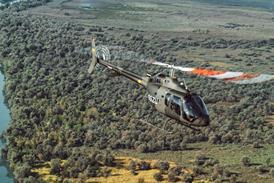One of the great fears during the Iraq war this year was that Saddam Hussein would launch Scud tactical ballistic missiles against Israel, as he had done in 1991. The threat was feared enough for the UK and the USA to deploy special forces into western Iraq to seek and destroy Scud transporter-erector-launcher vehicles before they could fire. Although there is relief in Israel that it was not targeted, it is tempered with regret that there was no real-life trial of the Israel Aircraft Industries Arrow anti-tactical ballistic missile (ATBM) system.
Although the Iraqi threat has disappeared, the Middle East is an area rich in TBMs, and Iran has just announced that it is preparing to put the 1,300km (700nm) range Shihab-3 into service. It also has the 2,000km Shihab-4 in the early stage of trials. Elsewhere, Libya, Saudi Arabia and Syria have Scud variants and/or its North Korean development, the No-Dong. The flight time of a Scud launched from southern Syria towards Tel Aviv would be less than 3min.
Ehud Zamir, manager Arrow programme business development at Israel Aircraft Industries' MLM division, says Arrow is the world's only operational ATBM. Such a capability has to be a standalone system, yet integrated with national command and control; it has to defend a large area and has to be able to provide early warning for itself and the general population; and it has to be able to deal with a variety of threats fired singly and in salvos, he says. A system also has to be cost effective, so IAI made the maximum use of commercial off-the-shelf products, says Zamir. The system has to be able to detect and classify a threat and do so within an achievable distance and as far away from centres of population as possible.
Arrow comprises the eponymous interceptor missiles and their six-round launcher; the Hazelnut launch control centre; the Tadiran Citron Tree battle management and fire control centre and the Elta Green Pine, L-band, long-range detection and fire control radar. As well as the system's radar, Israel is known to receive data from the US Defense Space Programme (DSP) early-warning satellites and the Boeing RC-135 Cobra Ball intelligence aircraft. The interceptors are launched vertically to give 360¡ coverage, are two-stage and fitted with a dual mode seeker - an electro-optical sensor that becomes active after the booster separates and a radio frequency mode to trigger the warhead. As the intercept can be endo- or exoatmospheric, the weapon has thrust-vectoring control. The missile has a warhead. "A warhead gives a better probability of hitting the targetÉ compared with a 'hittile', we can still destroy the missile if it is a few feet away," says Zamir.
The Iraq war proved that Arrow could be integrated into a multi-tiered air-defence system, says Lt Col Shahar Shochat, commanding officer of the Israeli air force's first Arrow missile squadron at the Palmachim air base on the Israeli coast. The battery is one of two operational Arrow units, with a third planned.
He says during the recent conflict the system was successfully integrated as the upper tier of a combined air-defence network. The lower element comprised US and Israeli Patriot PAC-2/3 and US Navy Aegis shipborne systems. "We proved we can operate with PAC-2, PAC-3 and Aegis. It's the first time we've had a two-tier air-defence system operational," says Shochat.
There was concern that communications between the systems would be an issue, he says, "but we made it work and didn't have to make changes".
During the conflict, the missile unit at Palmachim was able to detect Iraqi missile launches against Kuwait, says Shochat. Although the Green Pine can see into Iraq and Syria, the missiles were short range, suggesting the information was fed to Palmachim from either Aegis warships in the Gulf or the DSP network.
Israeli Patriot batteries are routinely integrated with the Citron Tree, where the battle commander will decide which missile system would engage the target, says Shochat.
The squadron comprises a headquarters co-located with the Green Pine and Citron Tree. The missiles are at the same base, but some distance from the fire control centre and radar, says Shochat. He describes the system as transportable rather than mobile, as it can be moved to other prepared sites but cannot be set up just anywhere. The radar, for instance, weighs 60t and comprises 2,000 transmit-receive modules: the launcher weighs 35t when loaded and each interceptor weighs 3.5t.
The Citron Tree fire-control centre has three banks of operator consoles laid out in a U shape. In the centre sits the centre commander who overseas the engagement, but also has links to the other parts of the battery as well as to air force headquarters. Shochat says national policy governs the batteries' engagements. Information available to the crew includes god's eyes' views with the incoming missile tracks, predicted impact points and engagement profiles.
On the commander's right sits the engagement officer, who ensures that targets are assigned to four other engagement officers sitting on the right-hand leg of the U. Each is assigned a geographical area to defend and two of the officers are more senior as they have an overview of Patriot batteries.
To the left of the commander is the resource officer, who monitors the status and readiness of the missiles. On the left of the U sits the sky picture officer, who is in contact with the home-front command and uses the Citron Tree's ability to predict impact point to alert the civil authorities. Also at these consoles are an intelligence officer and an after-action/debrief officer, who uses recordings as it is impossible to absorb all the information during engagements.
Source: Flight International























